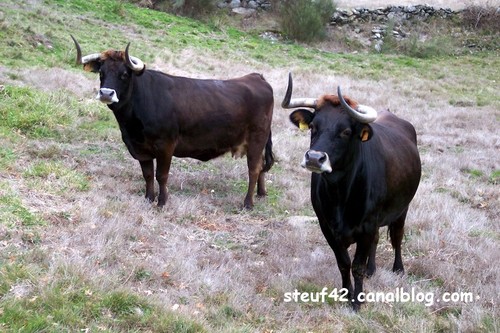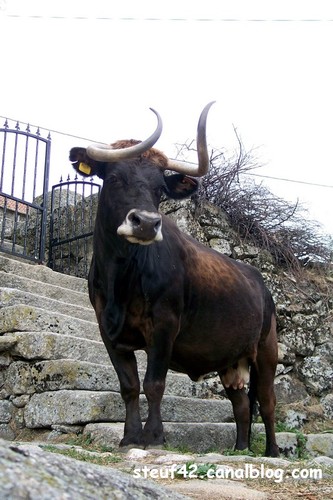Maronesa is very precious for several reasons. First of all, let's have a look at its phenotype. It is one of the very few European breeds in which most individuals have a perfectly correct aurochs colour that is really stable in the breed, only a number of cows have a reduced dichromatism, and some bulls might lack the dorsal stripe. Their curly forelocks give them an especially aurochs-like appearance, since this was a prominent facial feature of the aurochs. The horns of Maronesa bulls always face inwards, in some bulls to a very aurochs-like degree. The horns of the cows vary in shape, many have horn tips facing too much outwards to fit the aurochs (having a corkscrew-like shape), but there is still a number of female Maronesa with inwards-facing horns. Being a draft breed, many have a well-developed humps - bulls as much as cows. The body shape varies from being long-legged and slender to less long-legged. Bulls tend to be more longish than cows, I haven't seen a Maronesa bull with a squarely built body like in the aurochs yet. Maronesa also has a very prominent sex difference regarding size and body shape/proportions and horn thickness.
Their beautiful colour, forelocks, sexual dimorphism and often-good horns shouldn't let us forget their phenotypic deficiencies though; Maronesa tends to be a small breed, as small as Heck cattle or smaller. However, still some quite large animals, like bulls reaching 160 cm, appear. Maronesa is a fairly short-faced breed. Most animals have a concave head profile and a very shortened head, some bulls can be called "bulldog faced". The horns of many Maronesa are good and useful for breeding-back, but one aspect - the orientation relative to the skull - is suboptimal in most individuals. I estimate that the horns of Maronesa are about 20° lower than in the aurochs.
But as you know, appearance by far isn't everything. Maronesa often live freely all around the year, tolerate large amounts of precipitation and cold temperatures, and even have to defend themselves against wolves on occasion. So they are close to being being semi-feral in my opinion.
Now, here you find a selection of photos of Maronesa individuals that are quite aurochs-like or at least have an appealing appearance to me.
Although there should be around 5000 Maronesa (2000 individuals more than Heck cattle!), their numbers are falling. Moreover, their primitivity is at the danger of getting successively diluted by crossing with more derived breeds. Luckily breeding-back bought at least some herds to save and use their primitive phenotypic and ecologic features for "reconstructing" the aurochs. Tauros Project has one Maronesa herd in the Netherlands, and there is a herd in the Faia Brava reserve in Portugal too, although it is still nebulous to me if that herd is going to be part of the breeding-back project. I hope more herds are to follow. Numerous zoos in Central Europe have (often quite non-aurochs-like) Heck cattle displayed as "aurochs". Why not importing and showing some Maronesa instead? It would not be more of false labeling than with Heck cattle and it would contribute to secure good animals for breeding-back. I also hope that more grazing projects will use primitive breeds such as this one in the near future.
By forming herds exclusively composited of very aurochs-like Maronesa that would be selected for
- inwards-facing horn tips in both sexes
- not too short skulls
- tall and slender bodies
- well-expressed dichromatism
- large body size
an even more spectacular lineage of that breed could be created, especially if they would be kept under semi-feral conditions. Crossing in of Sayaguesa and Chianina would help to increase the body size, skull length and long-leggedness significantly. The undesired features of Chianina (colour dilutions and small horns) would require to use them in a separate herd where their negative features are out-crossed by using the second Mendelian rule. An upgrade of horn dimensions would be necessary as well. Barrosa would contribute yet more unwanted colour features and their horns are not that thick in cows, so Wörth Heck cattle might be a useful decision. But perhaps only in few doses to not bring in their dairy cattle body shape into the whole population.








In this link of article you will discover things about your bunny that you never knew. You may be shocked at what you find out in this article.
ReplyDelete